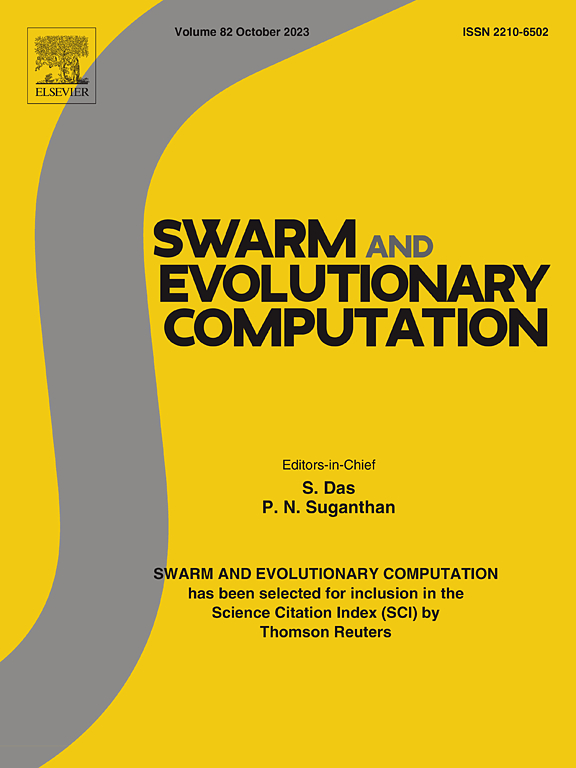Parrot优化算法改进多策略融合,用于医疗和工业领域数据特征优化
IF 8.2
1区 计算机科学
Q1 COMPUTER SCIENCE, ARTIFICIAL INTELLIGENCE
引用次数: 0
摘要
特征选择在机器学习、数据挖掘和模式识别中至关重要,旨在提炼数据特征,提高模型性能。医疗工业领域的数据特征数量众多,往往包含冗余和不相关的信息,影响了模型的效率和泛化能力。鉴于元启发式算法在处理复杂约束问题方面的优越性能已经被证明,并且许多研究人员将其用于特征选择处理数据,并取得了比传统方法更好的结果,本研究创新性地提出了一种改进的多策略融合鹦鹉优化算法(MIPO)来优化针对医疗工业数据的特征选择过程。MIPO包含四个核心机制:第一,平衡和优化觅食行为,以确定关键特征;第二,透镜成像反向驻留行为,加强局部搜索;三是纵向和横向交叉交流行为促进种群协同进化;第四,记忆行为智能引导搜索方向。此外,引入了安抚行为策略,增强了算法在复杂空间中的稳定性和鲁棒性。为了充分验证MIPO算法,本文设计了详尽的实验,包括烧蚀实验、与主流算法的对比实验以及与其他特征选择方法的对比实验,以证明其在多个维度上的优越性能。在S/V传递函数的基础上,构造了9个二值变体,以应对特征选择的多样性。实验结果表明,MIPO及其变体在23个医疗工业数据集上表现出高效、通用和强大的泛化能力。此外,通过结合KNN、SVM和RF分类器,MIPO显著提高了模型的准确率,与原始鹦鹉算法相比,其平均改良率分别为55.38%、35.53%和49.59%,并且最优变体在所有类型的分类器上也表现良好,最优变体的平均改良率分别为53.91%、34.38%和49.94%,证明了MIPO的广泛适用性。本研究深入探索MIPO与分类器的适应性,为实际应用提供科学指导和实用建议,不仅促进了特征选择领域的技术进步,也为医疗和工业领域的数据处理和分析提供了有力的工具。本文章由计算机程序翻译,如有差异,请以英文原文为准。
Parrot optimization algorithm for improved multi-strategy fusion for feature optimization of data in medical and industrial field
Feature selection is crucial in machine learning, data mining and pattern recognition, aiming at refining data features and improving model performance. Data features in the medical-industrial field are numerous and often contain redundant and irrelevant information, which affects model efficiency and generalization ability. Given that the superior performance of meta-heuristic algorithms in dealing with complex constrained problems has been demonstrated and many researchers have used them for feature selection to process data with better results than traditional methods, this study innovatively proposes an improved Multi-Strategy Fused Parrot Optimization Algorithm (MIPO) to optimize the feature selection process targeting the medical-industrial data. MIPO incorporates four core mechanisms: first, balanced and optimized foraging behavior to pinpoint key features; second, lens imaging reverse dwell behavior to strengthen local search; third, vertical and horizontal cross-communication behavior to promote population co-evolution; and fourth, memory behavior to intelligently guide the search direction. In addition, the pacifying behavior strategy is introduced to enhance the stability and robustness of the algorithm in complex space. To fully validate MIPO, this paper designs exhaustive experiments, including ablation experiments, experiments comparing with mainstream algorithms and comparisons with other feature selection methods, to demonstrate its superior performance in multiple dimensions. Based on the S/V transfer function, nine binary variants are constructed to cope with the challenge of diverse feature selection. The experimental results show that MIPO and its variants exhibit efficient, general and strong generalization capabilities on 23 medical-industrial datasets. Further, by combining KNN, SVM, and RF classifiers, MIPO significantly improves the model accuracy, with average improvement rates of 55.38%, 35.53%, and 49.59%, respectively, compared with the original parrot algorithm, and the optimal variant also performs well on all types of classifiers, with average improvement rates of 53.91%, 34.38%, and 49.94% for the optimal variant, proving the wide applicability of MIPO. In this study, the adaptability of MIPO and classifiers is deeply explored to provide scientific guidance and practical suggestions for practical applications, which not only promotes the technological progress in the field of feature selection, but also provides a powerful tool for data processing and analysis in the field of medical and industrial.
求助全文
通过发布文献求助,成功后即可免费获取论文全文。
去求助
来源期刊

Swarm and Evolutionary Computation
COMPUTER SCIENCE, ARTIFICIAL INTELLIGENCEC-COMPUTER SCIENCE, THEORY & METHODS
CiteScore
16.00
自引率
12.00%
发文量
169
期刊介绍:
Swarm and Evolutionary Computation is a pioneering peer-reviewed journal focused on the latest research and advancements in nature-inspired intelligent computation using swarm and evolutionary algorithms. It covers theoretical, experimental, and practical aspects of these paradigms and their hybrids, promoting interdisciplinary research. The journal prioritizes the publication of high-quality, original articles that push the boundaries of evolutionary computation and swarm intelligence. Additionally, it welcomes survey papers on current topics and novel applications. Topics of interest include but are not limited to: Genetic Algorithms, and Genetic Programming, Evolution Strategies, and Evolutionary Programming, Differential Evolution, Artificial Immune Systems, Particle Swarms, Ant Colony, Bacterial Foraging, Artificial Bees, Fireflies Algorithm, Harmony Search, Artificial Life, Digital Organisms, Estimation of Distribution Algorithms, Stochastic Diffusion Search, Quantum Computing, Nano Computing, Membrane Computing, Human-centric Computing, Hybridization of Algorithms, Memetic Computing, Autonomic Computing, Self-organizing systems, Combinatorial, Discrete, Binary, Constrained, Multi-objective, Multi-modal, Dynamic, and Large-scale Optimization.
 求助内容:
求助内容: 应助结果提醒方式:
应助结果提醒方式:


